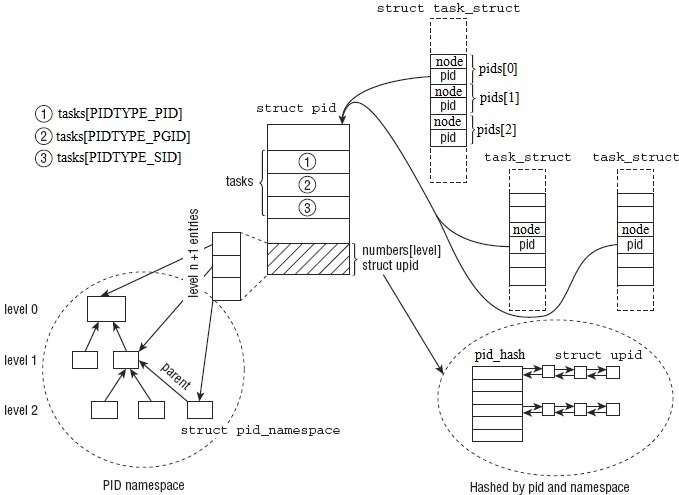Linux内核中的PID散列表实例
来源:互联网 发布:网络诈骗怎么定罪 编辑:程序博客网 时间:2024/04/27 23:14
开发平台:基于虚拟机的Ubuntu 11.04
内核源码:linux-2.6.38.8.tar.bz2
目标平台:ARM体系结构
参考文献:《深入Linux内核架构》
关于散列表的概念可以参考博文《散列表的基本概念及其运算》。
1、PID散列表
PID散列表是在系统启动过程中通过pidhash_init函数(被start_kernel函数所调用)所创建的。
PID散列表实际上就是一个像struct hlist_head pid_hash[i]这样的数组,其中i的大小由alloc_large_system_hash函数所确定,最大取值为4096,最小值为16。
- /* linux-2.6.38.8/kernel/pid.c */
- void __init pidhash_init(void)
- {
- int i, pidhash_size;
- pid_hash = alloc_large_system_hash("PID", sizeof(*pid_hash), 0, 18,
- HASH_EARLY | HASH_SMALL,
- &pidhash_shift, NULL, 4096);
- pidhash_size = 1 << pidhash_shift;
- for (i = 0; i < pidhash_size; i++)
- INIT_HLIST_HEAD(&pid_hash[i]);
- }
其中的alloc_large_system_hash函数能够根据机器物理内存的大小灵活地分配散列表的存储空间,以及改变pidhash_shift变量的默认值(默认值为4),从而确定pid_hash数组的大小(pidhash_size)。
最后,pidhash_init函数通过宏INIT_HLIST_HEAD把pid_hash数组的每个元素(struct hlist_head类型的变量)都初始化为空指针。
alloc_large_system_hash函数的实现比较复杂,没有时间也没有必要去分析它的每个语句,可以通过其中的打印语句来查看系统中的PID散列表到底有多大。
- /* linux-2.6.38.8/mm/page_alloc.c */
- printk(KERN_INFO "%s hash table entries: %ld (order: %d, %lu bytes)\n",
- tablename,
- (1UL << log2qty),
- ilog2(size) - PAGE_SHIFT,
- size);
例如,在基于虚拟机的Ubuntu 11.04中,当它的物理内存为512MB时,PID散列表的表项为2048个;当把物理内存修改为1GB时,PID散列表的表项提升到最大值4096个。
- //512MB物理内存
- $ dmesg | grep "PID hash table entries"
- [ 0.000000] PID hash table entries: 2048 (order: 1, 8192 bytes)
- //1GB物理内存
- $ dmesg | grep "PID hash table entries"
- [ 0.000000] PID hash table entries: 4096 (order: 2, 16384 bytes)
2、散列函数
PID散列表的散列函数为pid_hashfn,定义在linux-2.6.38.8/kernel/pid.c文件中。
- #define pid_hashfn(nr, ns) \
- hash_long((unsigned long)nr + (unsigned long)ns, pidhash_shift)
- /* linux-2.6.38.8/include/linux/hash.h */
- #define hash_long(val, bits) hash_32(val, bits)
- #define GOLDEN_RATIO_PRIME_32 0x9e370001UL
- static inline u32 hash_32(u32 val, unsigned int bits)
- {
- /* On some cpus multiply is faster, on others gcc will do shifts */
- u32 hash = val * GOLDEN_RATIO_PRIME_32;
- /* High bits are more random, so use them. */
- return hash >> (32 - bits);
- }
散列函数pid_hashfn先使关键字(nr和ns的和)乘以0x9e370001UL,然后取乘积的低pidhash_shift位(即bit[0]到bit[pidhash_shift-1])。例如,对于拥有2048个表项的PID散列表,散列函数pid_hashfn的返回值(取乘积的低11位)最终都会落在0到2047之间。
3、处理冲突
PID散列表采用链地址法来处理冲突。
4、PID散列表的运算函数
在介绍PID散列表的运算函数之前,先介绍一下相关的结构体。
struct pid是内核对PID的内部表示,而struct upid则表示特定的命名空间中可见的信息。
- /* linux-2.6.38.8/include/linux/pid.h */
- enum pid_type
- {
- PIDTYPE_PID,
- PIDTYPE_PGID,
- PIDTYPE_SID,
- PIDTYPE_MAX
- };
- struct upid {
- /* Try to keep pid_chain in the same cacheline as nr for find_vpid */
- int nr;
- struct pid_namespace *ns;
- struct hlist_node pid_chain;
- };
- struct pid
- {
- atomic_t count;
- unsigned int level;
- /* lists of tasks that use this pid */
- struct hlist_head tasks[PIDTYPE_MAX];
- struct rcu_head rcu;
- struct upid numbers[1];
- };
在struct upid中,nr表示ID(这里ID的类型有三种,定义在pid_type枚举中)的数值,ns是指向该ID所属命名空间的指针,所有的upid实例都通过pid_chain成员链接到pid_hash散列表中。
在struct pid中,count表示一个引用计数器,level表示该进程的命名空间在命名空间层次结构中的深度,而numbers是一个struct upid实例的数组,每个数组项(形式上只有一个数组项,但实际上可以根据需要进行扩展)都对应着一个命名空间。Tasks是共享此struct pid实例的所有进程的链表表头,其中的进程通过它的pids[type]成员来构建链接。在Linux内核中,通过attach_pid函数来建立它们之间的链接。
- /* linux-2.6.38.8/include/linux/pid.h */
- struct pid_link
- {
- struct hlist_node node;
- struct pid *pid;
- };
- /* linux-2.6.38.8/include/linux/sched.h */
- struct task_struct {
- ...
- struct pid_link pids[PIDTYPE_MAX];
- ...
- }
- /* linux-2.6.38.8/kernel/pid.c */
- void attach_pid(struct task_struct *task, enum pid_type type,
- struct pid *pid)
- {
- struct pid_link *link;
- link = &task->pids[type];
- link->pid = pid;
- hlist_add_head_rcu(&link->node, &pid->tasks[type]);
- }
以上所述各种结构体的关系如下图所示(图片修改自《professional linux kernel architecture》):

在Linux内核中,使用过散列函数pid_hashfn的只有alloc_pid和find_pid_ns两个函数而已。
(1)、插入运算
alloc_pid函数用于创建struct pid结构体实例。
- /* linux-2.6.38.8/kernel/pid.c */
- struct pid *alloc_pid(struct pid_namespace *ns)
- {
- struct pid *pid;
- enum pid_type type;
- int i, nr;
- struct pid_namespace *tmp;
- struct upid *upid;
- pid = kmem_cache_alloc(ns->pid_cachep, GFP_KERNEL);
- if (!pid)
- goto out;
- tmp = ns;
- for (i = ns->level; i >= 0; i--) {
- nr = alloc_pidmap(tmp);
- if (nr < 0)
- goto out_free;
- pid->numbers[i].nr = nr;
- pid->numbers[i].ns = tmp;
- tmp = tmp->parent;
- }
- get_pid_ns(ns);
- pid->level = ns->level;
- atomic_set(&pid->count, 1);
- for (type = 0; type < PIDTYPE_MAX; ++type)
- INIT_HLIST_HEAD(&pid->tasks[type]);
- upid = pid->numbers + ns->level;
- spin_lock_irq(&pidmap_lock);
- for ( ; upid >= pid->numbers; --upid)
- hlist_add_head_rcu(&upid->pid_chain,
- &pid_hash[pid_hashfn(upid->nr, upid->ns)]);
- spin_unlock_irq(&pidmap_lock);
- out:
- return pid;
- out_free:
- while (++i <= ns->level)
- free_pidmap(pid->numbers + i);
- kmem_cache_free(ns->pid_cachep, pid);
- pid = NULL;
- goto out;
- }
起始于建立进程的命名空间,一直到初始的全局命名空间,内核会为其中的每个命名空间分别创建一个局部PID,并把它们(用struct upid表示)都添加到pid_hash散列表中。
(2)、查找运算
find_pid_ns函数根据PID和命名空间指针来查找相应的struct pid实例。
- /* linux-2.6.38.8/kernel/pid.c */
- struct pid *find_pid_ns(int nr, struct pid_namespace *ns)
- {
- struct hlist_node *elem;
- struct upid *pnr;
- hlist_for_each_entry_rcu(pnr, elem,
- &pid_hash[pid_hashfn(nr, ns)], pid_chain)
- if (pnr->nr == nr && pnr->ns == ns)
- return container_of(pnr, struct pid,
- numbers[ns->level]);
- return NULL;
- }
其中,首先使用散列函数pid_hashfn确定所查找结点在散列表pid_hash中的表头,然后遍历表头所指向的链表,当nr和ns都匹配时,即找到了所需的struct upid结点,最后根据struct upid结点通过container_of宏获得包含它的struct pid实例。
- Linux内核中的PID散列表实例
- Linux内核中的PID散列表实例
- Linux内核中的PID散列表实例
- linux内核中的散列表
- Linux进程PID散列表
- Linux进程PID散列表
- linux内核PID管理
- linux内核PID管理
- linux内核PID管理
- linux内核pid哈希表
- PID散列表
- Linux内核原理-pid namespace
- Linux内核原理-pid namespace
- Linux内核中的pinctrl子系统应用实例
- Linux内核之pid为0和pid为1
- linux中的pid与tid
- 如何获取linux内核线程的pid?
- linux内核-分配PID位图算法
- Jqplot柱图前台代码
- Project configuration is not up-to-date with pom.xml
- [oracle][toad]TOAD连接ORACLE而不装ORACLE 客户端的方法
- 2010年 浙工大考研计算机专业课试题C++
- linux网络测速工具Speedometer(嵌入式工具集合)
- Linux内核中的PID散列表实例
- Cocoa中监听、观察和通知的五种方法
- HTML+CSS+JS实现左边栏滑动框带关闭按钮
- c#同步Socket
- 2011年 浙工大考研计算机专业课试题C++
- 大数据,且行且思
- 【道森试听】控制文件——Dave偶像
- Eclipse 打开已存在 Android项目
- Eclipse反编译插件 JD-Eclipse


